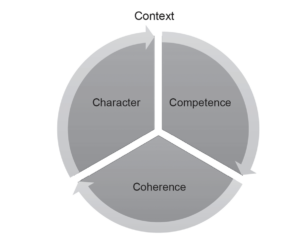Saturday, August 02, 2025
Saturday, August 02, 2025

by Charlotte Otter:
The leadership crisis is a crisis of leaders, in that we have the wrong people in place, creating the context in which we all live, shoring up rather than breaking down systemic problems. The fear-based, masculinist leadership style contributes to a context. That context – war, climate breakdown, political instability, violence against women and minorities, job instability, the rise of a billionaire class – creates a crisis for leaders.
The crisis for leaders
We live in a complex, multi-crisis world and no business exists context-free. Other geopolitical pressures include the rise of AI, the increased regulatory environment, mis- and disinformation, and the ongoing friction between employees and leaders on return to office policies.
Edelman’s 2022 Trust Barometer found that nearly one out of two of their 36,000 survey respondents view government and media as divisive forces, and people want more leadership from business.Their 2023 report showed again that business is the most trusted institution and is expected to ‘inform debate and deliver solutions on climate, DEI and skill training.’ And in 2024, while the media is still actively mistrusted, and trust in business is falling, business is still expected to deliver the most innovation to society.
The pattern is there: in a world where trust is being eroded, people look to business as the most trusted institution and the place from where societal innovation must be delivered.
So on top of all the pressures of leading a business, inspiring employees, assuring all the various audiences, growing and innovating, business leaders also need to stand up for society. Leaders need to have a deep understanding of a number of topics external to their business and take a meaningful position on them.
This is why I say this is a crisis for leaders: they carry a weight on their shoulders.
Rise of social media
Just as the paternalistic, mechanistic and transactional styles of leadership were beginning to be replaced by transformational leadership, social media arrived to hold up a mirror to everything a leader says and does. When I was leading executive communications, we received constant requests from employees, the DEI and social media team for executive commentary on breaking news. And in the moment, we had to adjudicate the request, get the executive’s buy-in and huddle with them on the nuances of the response.
And it’s a tightrope walk, because, with social media, everything a leader says is flashed around the world in an instant and remains on the public record for eternity. It’s reputational. Social media – and the blurring of boundaries between internal and external communication – has completely changed the leadership game. But a leader can’t respond to every breaking news event. If they speak on everything that happens in the world, they become a broadcast outlet and neglect their role in business. What they comment on becomes just as important on how they comment. It’s important for leaders to find a pathway through the social media jungle that is authentic to them, meaningful for their audiences, represents their business fairly, and shows their employees and external partners and audiences not only how much they care but that they care about the right things.
An additional challenge with social media is the amount of digital noise. Leaders need to have a strong point of view, backed up with insights and opinions, to break through for the right reasons.
Putting reputation at risk
What you say in response to a major world event is one thing; how you act is another. Acting too slowly, or not acting at all, can also be reputational.
When Russia invaded Ukraine on 24 February, 2022, the world was shocked. Many leaders adopted a wait-and-see attitude, perhaps hoping the war would be over quickly. Martin Boehringer and the leadership team of Staffbase, a German scale-up that creates software
for communications professionals, acted at lightning speed. One of their customers was a Russian state-owned business that Martin believed was using his company’s products to justify the war. This was against Staffbase’s people-centred values. He cancelled the contract on 24 February – having never done anything like this before – and posted the entire letter with the company’s name redacted on his personal LinkedIn.
Compare this to other companies that dragged their feet about exiting Russia, and as a result damaged their reputations. Jeffrey Sonnenfeld and his team at the Yale Chief Executive Leadership Institute began keeping an active list shortly after the war started. Only when the list was made public, did companies like Starbucks, Coca-Cola and McDonald’s pull out.
How, and how fast, companies act in response to major world events signals their values to the world. And any gap between what they say (their values) and what they do is a risk to reputation and threatens to break trust between the company and its audiences. When companies start to try to explain the gap, this is what we call ‘spin.’ Rupert Younger, who runs the Oxford University Centre for Corporate Reputation, says that ‘spin occurs when the story told begins to diverge too far from the reality.’
A recent example of this is the Kyte Baby scandal that broke in January 2024. Kyte Baby is an alternative baby clothes company that espouses strong parent-friendly values. However, when an employee requested the right to remote work when she and her partner adopted a baby who was born at 22 weeks and needed intensive care, she was fired.
After her sister made a TikTok video explaining what had happened, the Kyte Baby CEO responded with her own video saying she apologized to the employee for how her parental leave was handled and that the company would examine their leave policies. She came under fire for this – criticisms included that it seemed insincere, scripted and not enough. The CEO returned the next day with an unscripted video apologizing more, saying she regretted her ‘terrible decision’ not to let the employee work remotely.
The story made media headlines, including on CNN.[7] No CEO wants to make CNN for the wrong reasons. She compounded her error (firing) by trying to spin the story (first apology) and then hit the headlines for the wrong reasons (second apology).\
The gap is dangerous territory and is best handled by being as transparent as possible, as sincere and humane as possible, as quickly as possible. Or don’t behave badly in the first place.
CEOs behaving badly is a different reputational game from CEOs communicating bad news. Bad news is not uncommon in corporate life, but it’s how leaders handle it that differs. This was made starkly obvious with the layoff s in the tech industry between 2022 and 2024, and how different CEOs handled the messaging. (I cover this in more detail in Chapter 7 of the book.)
Conclusion
We are in a leadership crisis that is both of and for leaders. Bad leadership behaviour creates the context in which we live; good leaders have to find a pathway to success in that context. Whether they are good or bad, transactional or transformative, people lookto business leaders for innovation and solutions because they no longer trust governments or the press.
The way we think about work today is beset by systems of understanding that are centuries-old, and so implicit now that even mentioning one of them in a work context is likely to elicit surprise, if not rage. However, they are still there, threaded through our private and work lives, and informing our decisions and how companies attract, hire, retain and reward people who are not of the dominant work culture.
As we will see, companies and leaders gain reputations for character and competence. However, leaders are now expected to provide coherence for all audiences who feel confused and worried in the current context. You will see these aspects of reputation threaded throughout the chapters that follow. They are important for leaders seeking to build great reputations, and for communicators seeking to create a solid relationship with a CEO or leader.\
Figure 1: Aspects of reputation
Leaders who are conscientious about both company and their own reputation will build good relationships with their communicators. Leaders from diverse backgrounds or underrepresented minorities can partner with a communicator to foster career longevity and their next great leadership role. Under the overarching banner of protecting reputation, CCOs and the communications team will help leaders demonstrate character and competence, while creating coherence in confusing, contested and complex times.
+++
Charlotte Otter’s We Need New Leaders is published on 3 June 2025 by Practical Inspiration Publishing. Learn more about the book here.
Written by: Editor
© 2025 Stratpair Ltd., trading as Strategic. Registered in Ireland: 747736